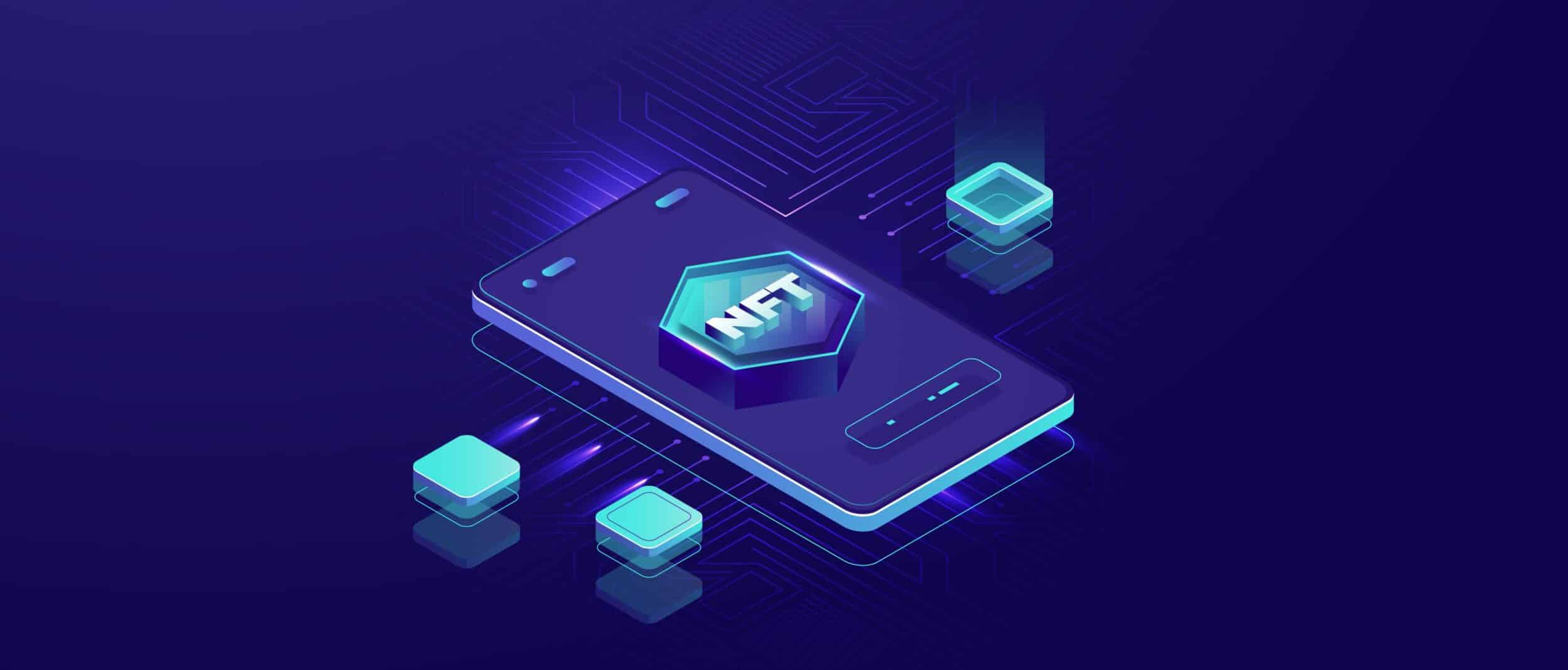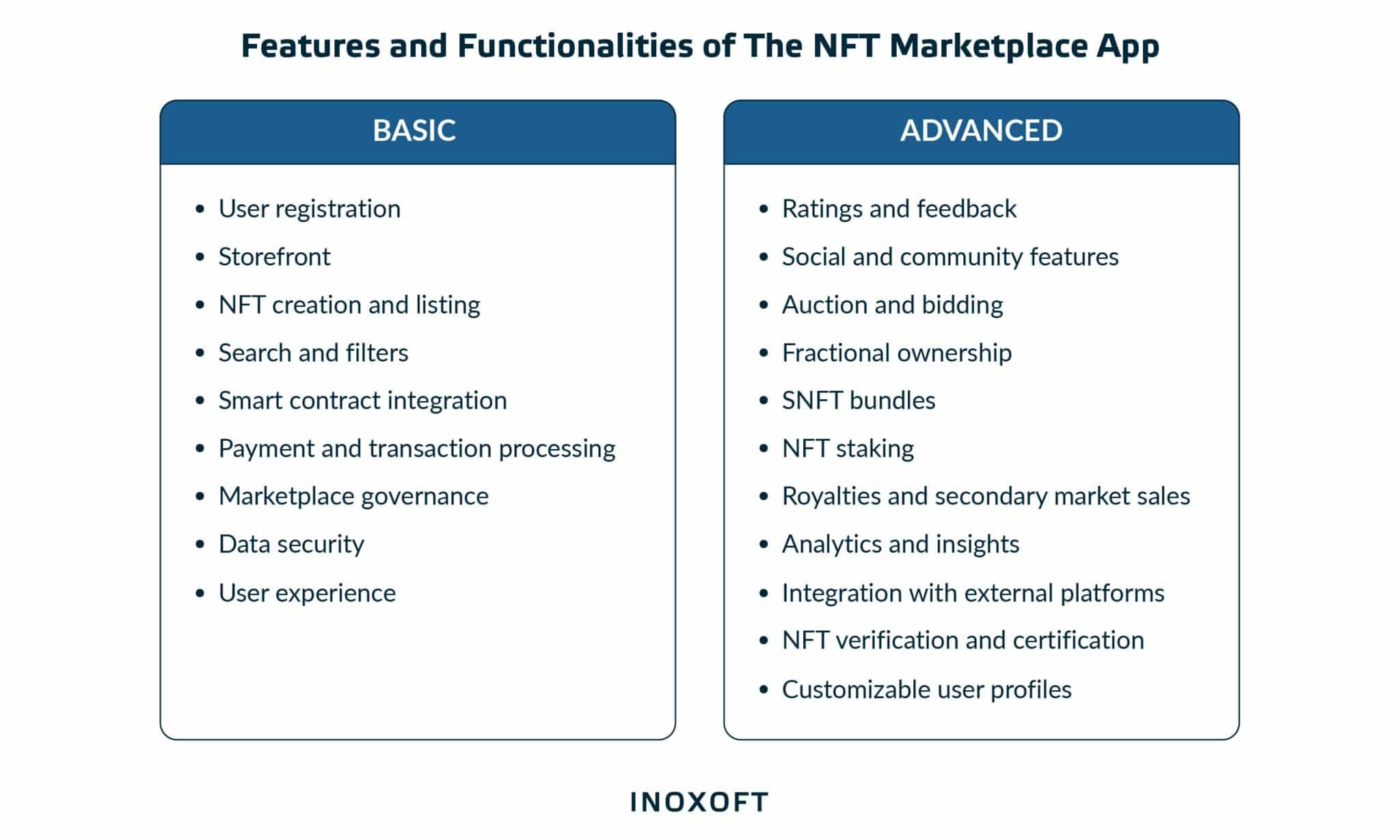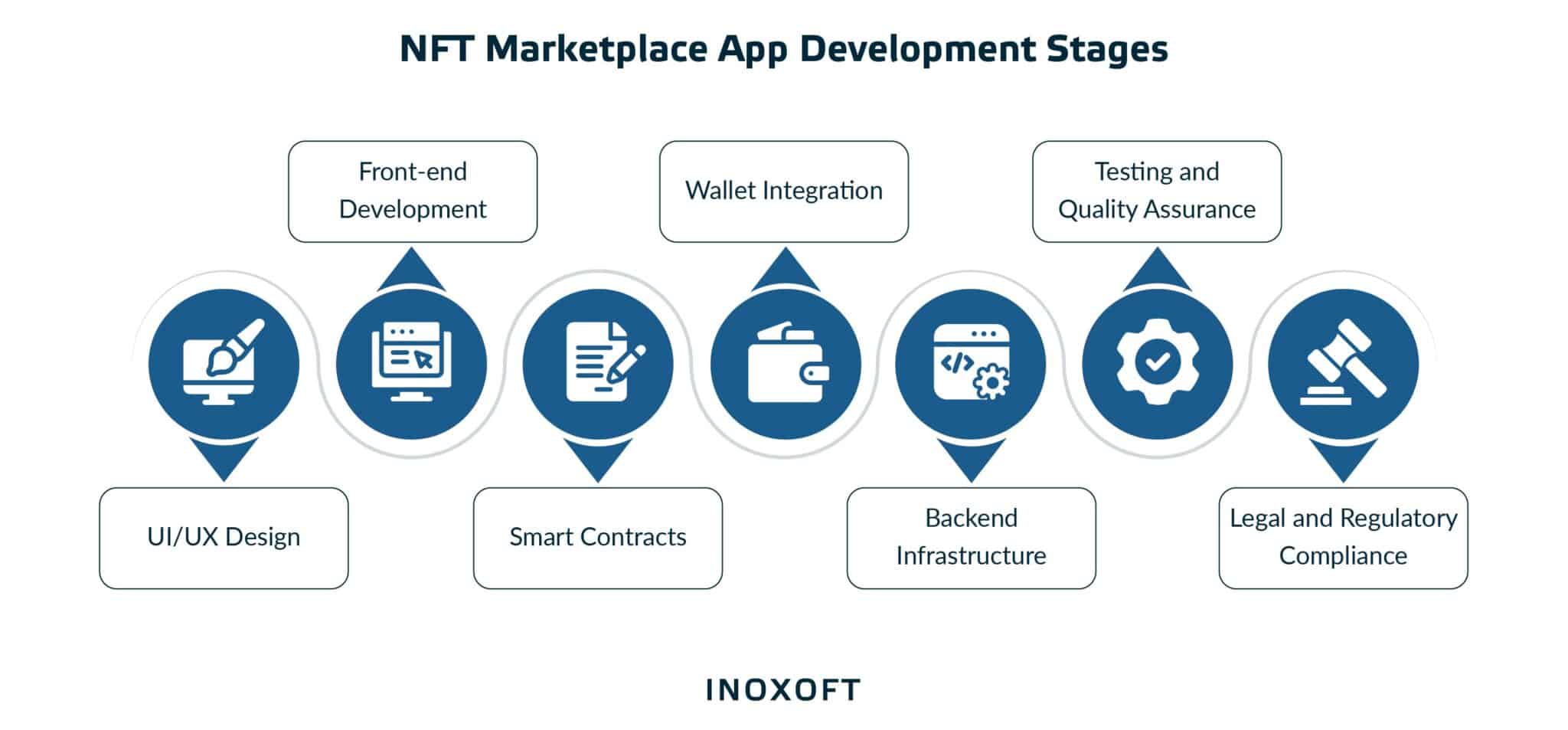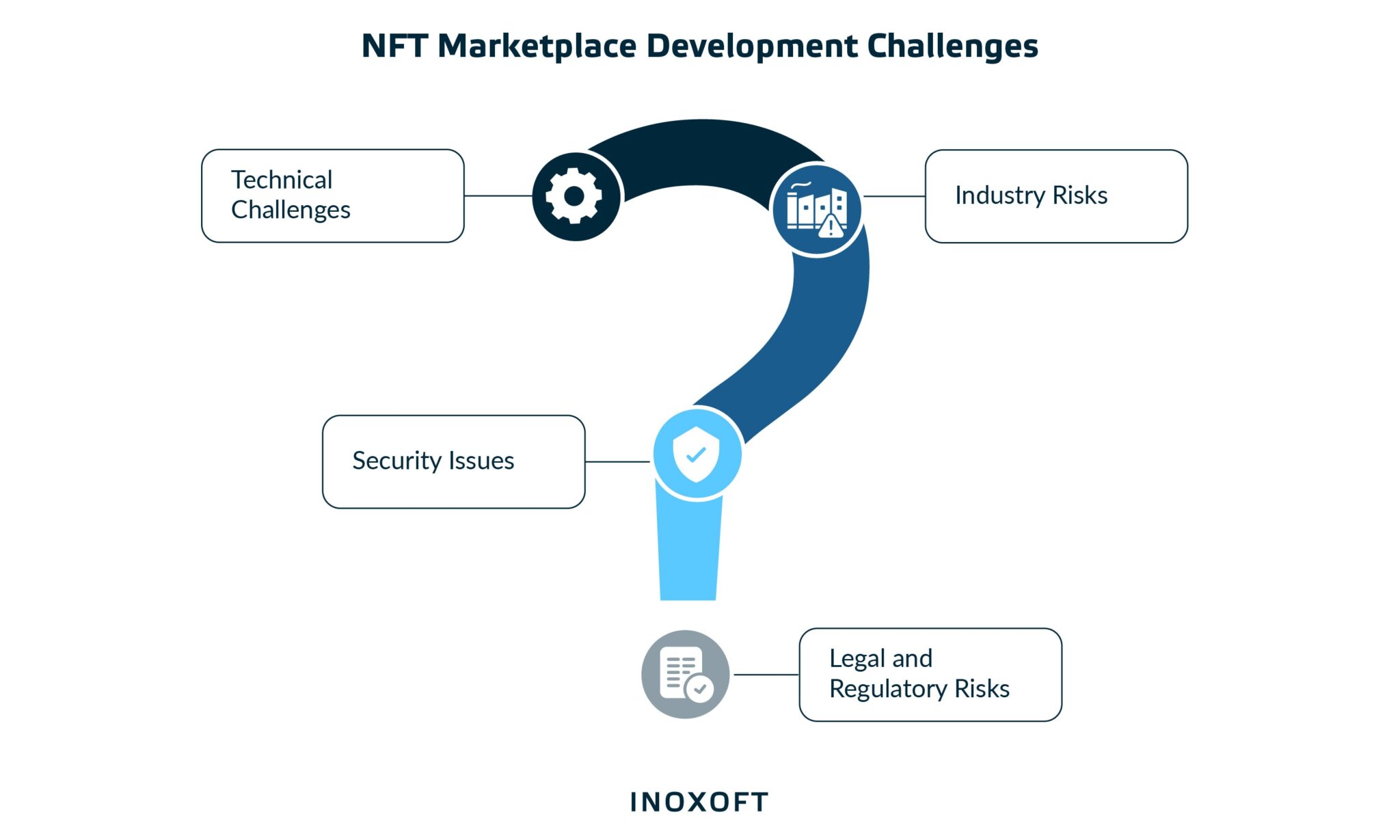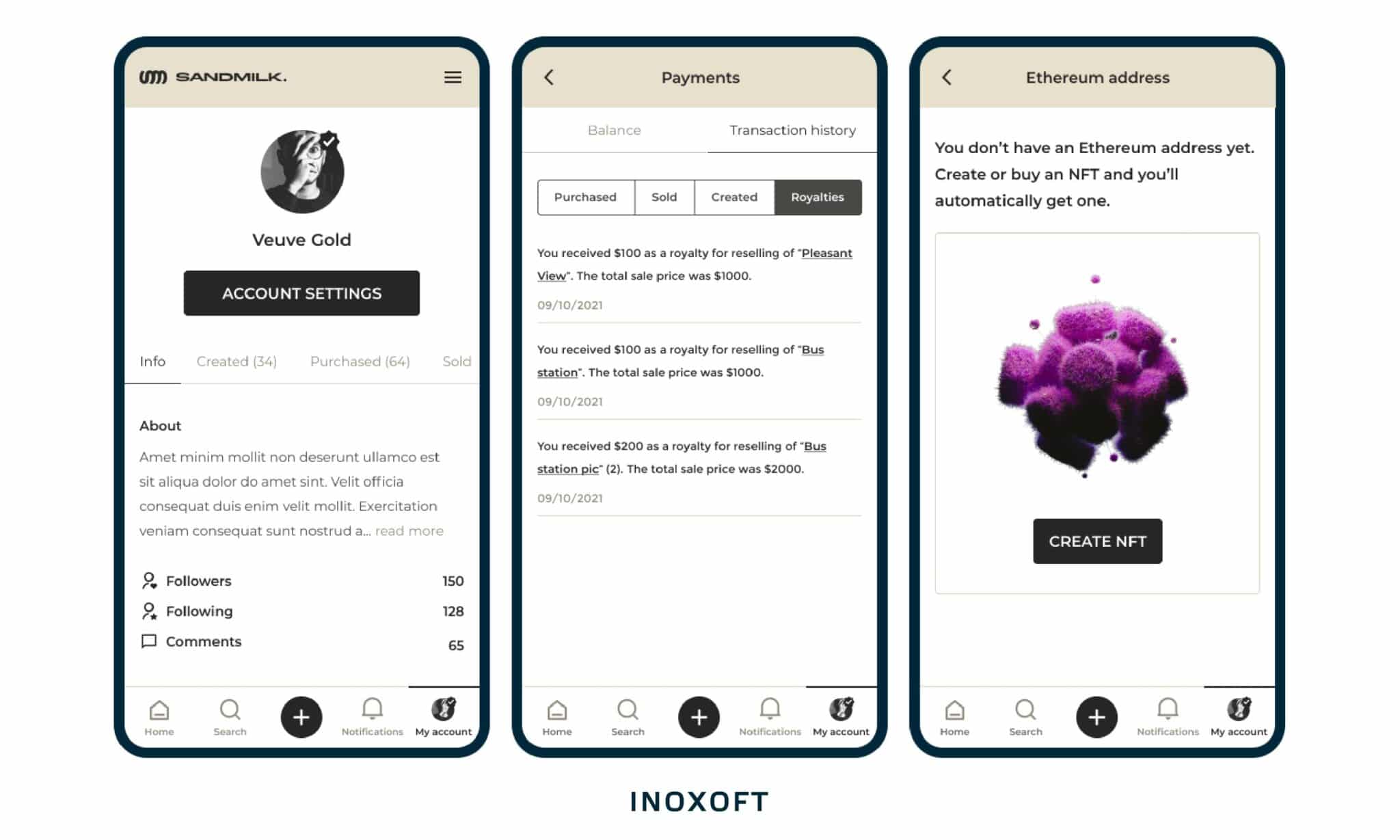NFTs, or non-fungible tokens, have become an increasingly popular way of buying and selling digital assets. Unlike infinite digital artworks, NFTs are about scarcity and exclusivity. Their constantly growing value creates excellent opportunities for creators and marketplaces. NFT web platforms and apps generate revenue through transaction or listing fees, royalties, and other monetization strategies.
This article will explain how to develop an NFT marketplace app featuring blockchain platforms, smart contracts, and wallet integration. We'll also delve into the importance of market analysis, legal and regulatory compliance, and promotion in ensuring the success of an NFT marketplace.
This article’s insights rely on the Inoxoft team’s rich experience in NFT marketplace app development. Our specialists build advanced blockchain solutions, demonstrating excellent industry knowledge and outstanding project management skills. Here, we will provide some extra development details and approaches on the example of the NFT platform for creators and collectors.
- Plan Your NFT Marketplace
- Market research
- Define marketplace features
- Choose a blockchain platform
- Develop a business model
- NFT Marketplace App Development
- UI/UX design
- Front-end development
- Smart contracts
- Wallet integration
- Backend infrastructure
- Testing and Quality Assurance
- Legal and regulatory compliance
- Launch and Promote Your NFT Marketplace
- NFT marketplace launching
- Promoting
- Manage and Scale Your NFT Marketplace
- NFT marketplace managing
- NFT marketplace scaling
- NFT Marketplace App Development Challenges
- Technical challenges
- Industry risks
- Security issues
- Legal and regulatory risks
- Consider Inoxoft for your NFT Marketplace Development
- NFT Marketplace for Creators and Collectors
- Conclusion
Plan Your NFT Marketplace
NFT marketplace app development requires careful planning and consideration to ensure its success and optimize costs. Let’s explore the essential steps to take when building such a solution.
Market research
Before developing an NFT platform, it’s crucial to conduct a thorough market analysis. Thus, you will identify the niche market, unique selling proposition (USP), and target audience. This way, you will develop your customers‘ needs and preferences in mind. Besides, your product will have a competitive edge in the market.
Niche market and USP
With the help of market research, you will identify a niche market and USP for your NFT platform. Besides, you can determine the types of NFTs customers want to trade and the features they need in an NFT platform. For example, the platform may focus on a specific NFT type like art, music, or collectibles.
Also, it’s a good idea to come up with a unique selling proposition. It’s a statement that highlights the NFT platform’s most significant benefits or features that set it apart from direct competitors. Some examples of a USP are a user-friendly interface, low fees, or unique characteristics like fractional ownership.
Competitor analysis
Analyzing competitors involves assessing the strengths and weaknesses of existing NFT platforms. You should understand their pricing strategies, target audience, and marketing campaigns. This research type usually includes the following approaches:
- Studying publicly available information
- Conducting surveys and focus groups
- Analyzing market reports
NFT platform developers can use such analysis to understand the competitive landscape. Hence, they will determine ways to make their product stand out. For example, developers can identify areas where competitors don’t address customer needs and develop a solution covering those gaps.
Target audience portrait
Another essential task is to define a specific customer group potentially interested in buying and selling NFTs. To identify those users, you can adopt various methods like market segmentation, surveys, focus groups, and demographic analysis.
The information about customers’ average age, gender, and interests helps you develop marketing campaigns and product features resonating with your target audience. For example, suppose your research shows that your users are much into music. Then, your NFT platform could focus on the related NFTs and develop appealing features like social media integration.
Define marketplace features
To create a user-friendly platform that meets the traders’ needs, define the right features for your NFT marketplace.
Stay tuned to learn the basic and advanced features of a thriving NFT marketplace.
Basic features and functionalities
The required features vary depending on the specific platform. However, some basic elements are essential to any NFT marketplace:
- User registration. The signup process should be straightforward and intuitive. Thus, users will have a positive first impression when entering your platform for the first time.
- Storefront. A storefront is the main interface component where buyers can browse and purchase NFTs. In turn, sellers list and manage their NFTs there.
- NFT creation and listing. Create a user-friendly option to upload images, videos, and NFT descriptions.
- Search and filters. Let users search and filter through listings based on various criteria, such as price, category, and popularity.
- Smart contract integration. This feature automates the transaction process. Also, it ensures a secure and transparent transfer of NFTs.
- Payment and transaction processing. Allow users to choose the preferred payment method when purchasing. The options may include credit cards, cryptocurrencies, and more.
- Marketplace governance. The marketplace should have clear rules and policies. In particular, these are guidelines for listing NFTs, resolving disputes, and handling refunds.
- Data security. Implement encryption protocols, two-factor authentication, and other measures to prevent data breaches and cyber-attacks.
Advanced features and functionalities
Advanced features can set your NFT marketplace apart from competitors and provide additional value to your users. Here are some of the most interesting options.
Ratings and feedback. This feature creates a sense of trust and transparency between buyers and sellers. It also improves the quality and reputation of an NFT marketplace.
- Social and community features. Enhance user engagement and encourage collaboration through chat rooms and forums. Also, provide the ability to follow other users and artists.
- Auction and bidding. These perks can boost user engagement and drive interest in particular NFTs.
- Fractional ownership. You can allow multiple investors to own some part of an NFT. It increases liquidity and makes digital assets more accessible to potential stockholders.
- NFT bundles. Users may want to buy multiple NFTs at once. Discounts encourage larger purchases and enhance sales.
- NFT staking. With this feature, users can earn rewards for holding and staking their NFTs in a platform-based wallet. Such a bonus will drive more NFT enthusiasts to your platform.
- Royalties and secondary market sales. Artists and creators could earn a percentage of the sale price when someone resells their NFTs on your marketplace. This opportunity will create a sustainable revenue stream.
- Analytics and insights. Valuable data on NFT sales trends, user behavior, and key metrics keep users informed. Besides, it facilitates buying and selling decisions.
- Integration with external platforms. Integrations with social media, gaming, and entertainment platforms boost NFTs’ visibility and drive sales.
- NFT verification and certification. You can establish NFTs’ authenticity and provenance, improving their value to buyers. Moreover, your customers will be more likely to trust your platform.
- Customizable user profiles. Ensure users can showcase their NFT collections and enjoy a personalized experience on your platform.
Choose a blockchain platform
The blockchain platform is a crucial aspect of any NFT marketplace. It determines your solution’s technical capabilities, performance, and security. Different options offer unique features, so let’s overview the most popular ones.
Ethereum
Ethereum is an open-source, decentralized blockchain platform for NFTs. It supports smart contracts and the ERC-721 standard, which is perfect for creating and managing NFTs. Ethereum also has a large and active developer community. It helped come up with various tools and resources for building NFT marketplaces.
Binance smart chain
Binance Smart Chain is a blockchain platform offering faster transaction speeds and lower fees than Ethereum. It also supports smart contracts and the BEP-721 standard compatible with Ethereum’s ERC-721. Additionally, Binance Smart Chain ensures easy transfer of NFTs between the two platforms.
Polygon
Polygon is a Layer 2 scaling solution for Ethereum. It offers faster and cheaper transactions than the solutions mentioned above. Also, Polygon supports smart contracts and the ERC-721 standard, competing with Ethereum-based NFTs and marketplaces. It’s an attractive choice for scaling and reducing transaction costs.
Flow blockchain
Flow is a blockchain platform that focuses on NFTs and other digital assets. It offers faster transaction speeds and higher scalability than Ethereum. Moreover, Flow provides built-in NFT creation and management support.
Flow’s unique architecture also separates data storage and processing. It results in better performance and reduced costs. Also, it partners with major companies, such as NBA Top Shot and Ubisoft, providing some additional opportunities.
Develop a business model
NFT marketplace app development involves identifying the key marketplace elements and determining ways to generate revenue. Here are the most critical steps to take.
Cost structure
First, identify the costs associated with operating the NFT marketplace, including development, hosting, and maintenance expenses. This way, you will determine the revenue model and pricing strategy, ensuring the marketplace is profitable.
Revenue model
Revenue models for NFT marketplaces vary depending on the marketplace’s specific needs and goals. Here are some options to choose from.
- Transaction fees. It charges a fee for every transaction on the marketplace (mostly a percentage of the sale price).
- Listing fees. Depending on the marketplace’s pricing strategy, it can be a one-time or recurring fee.
- Subscription fees. Some NFT marketplaces may charge a subscription fee to access certain features or services on the platform.
- Royalties. Taking a percentage of the sale price can encourage creators to list their NFTs on the marketplace. This approach will provide ongoing revenue for your marketplace.
- Advertising. It includes sponsored content or targeted ads based on user behavior and preferences.
Pricing strategy
Finally, consider the fee structure and pricing for various services like listing NFTs or conducting transactions.
NFT Marketplace App Development
Building an NFT marketplace is a complex process that requires a team of experts in various fields. Let’s have a look at the core aspects of the development lifecycle.
UI/UX design
Last but absolutely not least, check the flawlessness of the application and its readiness for the final launch. Inspect every function and process to ensure the app is free from bugs or glitches. After the release, you’ll be able to adjust and add features for users’ liking. Do not forget the importance and usefulness of building MVP and its testing.
Here are the most critical aspects of an effective UI/UX design:
- Consistency and branding. A consistent visual brand establishes trust and recognition. Use an attractive color scheme, typography, and imagery to ensure it.
- Intuitive navigation. Users should quickly and easily find what they’re looking for. To achieve it, provide a well-organized menu system, clear categories and filters, and simple search functionality.
- Clear and concise messaging. The messaging should be brief and straightforward. Use understandable language to convey essential information to users. It includes descriptions of NFTs, seller profiles, and transaction details.
- Responsive design. It’s crucial to ensure a responsive design that fits different screen sizes and resolutions.
- Testing and iteration. Regularly test and iterate on your NFT marketplace’s UI/UX design of the NFT marketplace. Use customer feedback to improve the platform and adapt it to your audience’s current needs.
Front-end development
Front-end developers use HTML, CSS, JavaScript, and other programming languages to implement the marketplace’s visual design and functionality. This way, you get a fully-functioning platform that meets creators’ and buyers’ needs.
- Interactivity. Users should meaningfully engage with the platform by bidding, buying, selling, and sharing NFTs.
- Performance. The front-end should ensure optimal performance, which involves fast load times and smooth user interactions. You can achieve this goal by optimizing images and applying caching and compression techniques.
- Accessibility. Ensure that all users can benefit from the platform regardless of their age and abilities. In particular, consider the alternative text for images, keyboard navigation, and compatibility with assistive technologies.
Smart contracts
Smart contracts are a must-have component of NFT marketplaces. They enable a secure and transparent creation, ownership, and transfer of NFTs.
Smart contracts should handle the NFT marketplace’s specific logic. It includes creating and transferring NFTs, verifying ownership, facilitating transactions, and distributing royalties. Also, note that smart contracts on Ethereum require using gas. It’s a unit of measure for the computational cost of executing a transaction on the network.
Wallet integration
Thanks to wallet integration, users can securely store, manage, and transfer their NFTs. Here are some key aspects to consider in this regard.
- Wallet choice. Many wallets support NFTs. The main options are hardware wallets like Ledger and Trezor, software wallets like MetaMask and MyEtherWallet, and mobile wallets like Trust Wallet and Coinbase Wallet. The choice depends on security, ease of use, and platform compatibility.
- Integration with smart contracts. Make sure users can interact with their NFTs seamlessly and securely. They should be capable of verifying ownership, initiating transfers, and receiving payments through their wallets.
- User interface. Include features like NFT display, search and filter options, and transaction history.
- Security. Prioritize security, as any vulnerabilities can lead to losing funds or NFTs. Stick to best practices for secure key storage, encryption, and multi-factor authentication.
- Compatibility. The wallet should be compatible with the platform and smart contract your NFT marketplace uses. It should also support various NFT standards like ERC-721 and ERC-1155.
- Customer support. Robust customer support critically impacts your NFT marketplace’s success. Users should get timely and helpful assistance solving their issues and answering questions regarding wallets, NFT management, and more.
Backend infrastructure
The backend infrastructure supports the platform’s core functionality and enables a seamless user experience. The stack for NFT marketplace app development typically depends on the project’s requirements and specifics. However, the following backend technologies are the most likely to come in handy.
- Smart contract language: Solidity, Vyper, Rust
- Web framework: Node.js, Django, Ruby on Rails
- Database: MySQL, MongoDB, PostgreSQL
- Payment gateway: Coinbase Commerce, BitPay, CoinPayments
- Cloud hosting: Amazon Web Services (AWS), Microsoft Azure, Google Cloud Platform (GCP)
- Other tools: IPFS for decentralized storage, JSON Web Tokens (JWTs) for authentication, and APIs for integrating with external services
Testing and Quality Assurance
Testing and quality assurance are essential components of NFT marketplace development. They help identify and address bugs and issues as early as possible. Thus, you won’t have to deal with those problems after the platform’s launch.
The most widespread practices you may apply at this stage are unit, integration, user acceptance, load, security, regression testing, and quality assurance.
Legal and regulatory compliance
Here are some primary considerations for legal and regulatory compliance during NFT marketplace development.
The legal and regulatory environment
The legal and regulatory environment for NFT marketplaces can vary by jurisdiction. For instance, the requirements in the US and EU are different:
- In the US, the Securities and Exchange Commission (SEC) regulates the sale of securities involving some NFT types.
- In the EU, the General Data Protection Regulation (GDPR) sets data protection and privacy standards regarding all Internet activities, including NFT trading.
Compliance with AML and KYC regulations
These rules state that an NFT platform must have specific systems to verify users’ identities. This way, a marketplace should monitor transactions for potential money laundering or terrorist financing activities. Let’s look at some examples of such regulations.
- The Financial Action Task Force (FATF) provides international standards for anti-money laundering and counter-terrorism financing measures. Many national laws and regulations stick to those principles.
- In the US, the Financial Crimes Enforcement Network (FinCEN) regulates AML and KYC requirements for virtual currency businesses.
Intellectual property rights protection
NFT marketplaces often involve selling or transferring digital assets protected by intellectual property laws. In particular, these are the copyright and trademark legislations:
- Copyright law provides legal protection for original creative works. That also applies to digital art and other NFTs that are subject to copyright protection.
- Trademark law covers legal protection for logos, brands, and other identifying marks, including the ones associated with NFTs and related marketplaces.
Launch and Promote Your NFT Marketplace
Launching and promoting your NFT marketplace is another critical step to your platform’s success. Here, your goal is to build awareness and excitement around your solution, attract potential buyers and sellers, and generate revenue.
NFT marketplace launching
Let’s explore the two essential steps for launching your NFT marketplace.
1. Beta testing
When conducting beta testing, you verify your platform’s performance with a selected group of users. Thus, you can identify and fix bugs, glitches, or usability issues before bringing your product to the market. It’s an excellent opportunity to gather feedback from early users, fine-tune your platform, and ensure it’s ready for a broader release.
2. MVP launch
Next, it’s time to launch your minimum viable product (MVP). An MVP is the most basic version of your platform that includes the most critical features aimed to attract users and generate transactions. If you launch your MVP as early as possible, you can get valuable feedback, iterate on your platform, and build the initial user base.
Promoting
Your marketing and promotion efforts are vital for building a thriving platform. Let’s highlight the most efficient methods to achieve the desired results.
- Branding. Creating a unique brand identity that reflects your NFT marketplace’s values and goals is crucial. It should include a logo, color scheme, and tagline to make your platform stand out.
- Search Engine Optimization (SEO). Optimize the content, meta tags, images, and URLs to increase visibility and drive organic traffic.
- Paid advertising. With this approach, you can reach a wider audience and generate traffic to your NFT marketplace. Consider pay-per-click (PPC), display, or social media advertising.
- Community building. You can reach this goal through social media groups, forums, or chat rooms.
- Partnerships. Partnering with influencers, artists, and other NFT marketplaces increases exposure and drives traffic to your platform.
- Public Relations (PR). Press releases, media coverage, and interviews will generate buzz around your NFT marketplace.
- Analytics and metrics. Focus on metrics like traffic, engagement, and conversion rates to improve your marketing strategies and overall performance.
Manage and Scale Your NFT Marketplace
Once you have launched your NFT marketplace, it’s time to set up an effective management and support strategy. Additionally, as the number of users and transactions increases, scaling the infrastructure of the marketplace becomes necessary. This way, you can effectively maintain performance and accommodate growth.
NFT marketplace managing
Here are some insights into managing your NFT marketplace.
- Customer support. By responding to user inquiries through email or chat, you can guidance through the platform and address technical issues. You should also establish a system to monitor problems your users face and resolve them on time.
- Escrow services. Escrow services ensure your marketplace’s security and transparency. They refer to holding the payment from a buyer until a seller has transferred the NFT to their wallet. This way, both parties fulfill their obligations in the transaction. Some popular escrow services for NFT marketplaces are OpenSea, EscrowCoin, and TrustSwap.
- Dispute resolution. A precise and efficient dispute resolution helps resolve customers’ issues quickly and fairly. This process involves mediation or arbitration by a third-party service provider. Your platform should offer clear policies and procedures for handling potential controversy.
NFT marketplace scaling
Scaling an NFT marketplace is about growing and accommodating more users, transactions, and assets. Here are several key areas to focus on:
- Upgrading infrastructure. This step ensures that your platform’s backend can handle the increased demand and load. It may require upgrading servers and databases, implementing caching, load balancing, and other performance optimization techniques.
- Adding new features. As the platform grows, users’ needs and expectations tend to change. Introducing new features like social media integrations or auctions keeps your users engaged and attracts new customers. However, balancing new features with maintaining the existing performance and usability is crucial.
- Entering new markets. You can expand your platform’s coverage by supporting different languages and currencies. Alternatively, you may introduce new NFT categories to appeal to new demographics. But first, conduct in-depth research to ensure your platform will meet new audiences’ needs and preferences.
NFT Marketplace App Development Challenges
OpenSea-like app development presents numerous challenges and risks one should consider and address to ensure a successful launch and long-term viability.
Technical challenges
NFT marketplace software development covers complex technical aspects like smart contract creation and blockchain and wallet integration. It leads to the following potential challenges:
- You should seamlessly integrate NFTS into your platform to provide a smooth user experience.
- It’s necessary to guarantee the platform’s scalability and security to accommodate increasing traffic and transactions.
- Your marketplace must achieve interoperability with different blockchain platforms to use NFTs across various ecosystems.
Industry risks
The NFT market is new and fast-growing, which leads to market uncertainties and risks. One of them is the crypto market’s volatility which affects the value of NFTs. The demand for NFTs can fluctuate, making businesses’ growth potential unpredictable. Also, the emergence of new competitors and market disruptions may result in market share erosion.
Security issues
The decentralized and immutable nature of blockchain provides security benefits. However, NFT marketplaces are still vulnerable to hacking, leading to the theft or loss of NFTs. Therefore, security is a significant concern for NFT marketplaces that involve high-value assets and transactions. To address this challenge, you should provide robust security protocols like two-factor authentication and data encryption.
Legal and regulatory risks
NFT marketplaces operate in a complex legal and regulatory environment. Compliance with AML and KYC regulations is critical to prevent fraud and other financial crimes. Besides, intellectual property rights are also risky. That’s because scammers sometimes copy copyrighted NFTs, leading to infringement claims.
Consider Inoxoft for your NFT Marketplace Development
Inoxoft offers advanced solutions for building an NFT marketplace from scratch. Here are the related opportunities and services we offer to our clients.
1. With white-label NFT development, you can launch a customizable trading platform under your brand with all the necessary features. You can also order customer support, technical support, and marketing services. Therefore, you shouldn’t build a solution from scratch and can focus on your essential business tasks.
Our team can deliver advanced features unavailable in conventional NFT markets:
- Customizable smart contracts
- Real-time bidding
- Advanced analytics
- Social functions like chat
- Integrations with other blockchain services, such as DeFi platforms
2. We create different types of NFT art markets — universal, social, artistic, and more. With their help, you can streamline the trading process and provide your community with new investment and collectible opportunities.
We can help you cover the following objectives:
- Create a trading platform MVP following the ERC 721 and ERC 1155 specifications.
- Develop an iOS or Android application for an existing NFT platform.
- Create and introduce new NFTs into existing markets.
Now, let’s consider the process of creating an NFT marketplace based on one of our projects.
NFT Marketplace for Creators and Collectors
The client asked us to create a user-friendly and secure web-based NFT platform with digital art authentication. At the same time, they wanted to avoid complex blockchain processes.
We offered a responsive platform with affordable tools for converting digital artworks into NFTs. The solution supports credit card or Stripe payments. So users don’t need to create crypto wallets to start trading. But behind the scenes, the system creates a blockchain-based contract for each transaction.
Customers can create digital content on this platform and then sell, buy, and transfer it using this platform. Artists can again choose from different license types — unique, limited, or unlimited.
The innovative mechanism of simplified access to the platform made it available to a broad audience. As a result, the company has every chance to reach the top of the global NFT markets.
Conclusion
NFT marketplace app development requires specific technologies like blockchain platforms, smart contracts, and wallet integration. Thanks to these critical components, users can create and exchange unique digital assets on a secure and decentralized platform.
However, the development process is not limited to just technology. Thorough market analysis and legal compliance are essential, as well. Promotion is another key to the marketplace’s success — without effective marketing strategies, it is hard to attract many users.
Finding a reliable development partner can help mitigate the risks of developing an NFT marketplace app. With the right vendor, your platform can become a game-changer in digital assets.
Do you want to create NFT store? Contact our team to discuss your upcoming project’s functionality, timeline, and budget.
Frequently Asked Questions
What are the most popular NFT marketplace apps?
Here are the most popular NFT marketplace apps:
- OpenSea (art, gaming items, and collectibles)
- Crypto.com (art, music, and sports collectibles)
- Binance NFT (art, gaming items, and collectibles)
- Mintable (art, music, and collectibles)
- SuperRare (high-end digital art)
How long does it take to create an NFT marketplace app?
The development time depends on several factors, including the chosen platform, the number and complexity of features, and the development team's expertise. On average, it takes six to twelve months to create an outstanding NFT marketplace application. Contact Inoxoft to estimate the duration of your project.
How much does it cost to build an NFT marketplace?
The cost of building an NFT marketplace app varies significantly based on the chosen platform, features, and your developers’ location. Also, it depends on the hired specialists’ specifics (in-house professionals, freelancers, and extended or dedicated teams have different hourly rates).
For example, MVP with smart contract integration, search, listing, payment processing, and security may cost you around $50,000. In contrast, the price of a custom NFT marketplace app with rating, auction, analytics, social media integration, and other advanced features is approximately $500,000. To get a detailed calculation of the project budget, contact our team.
